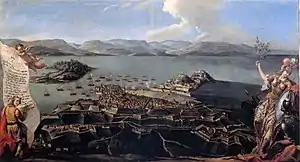Provveditore Generale da Mar
The Provveditore Generale da Mar ("Superintendent General of the Sea") was a senior office in the Venetian navy and in the Venetian overseas empire.

The Provveditore Generale da Mar was the supreme commander of the Venetian fleet in peacetime. In wartime, he was replaced by the Capitano Generale da Mar, with more ample powers.[1] The office usually had a tenure of three years, but in wartime, the nomination of a new Capitano Generale da Mar was usually accompanied also by the election of a new Provveditore Generale.[2] From the first half of the 16th century, he also appears as the governor of the Venetian Ionian Islands. Eventually this appointment became regularized, as the Provveditore Generale del Levante; with his seat at Corfu, the Provveditore Generale da Mar was the senior civil and military governor of the Ionian Islands in peacetime.[3][4]
Typically he hoisted his ensign on a bastard galley, although in later times he was allowed to use a sailing ship of the line instead.[2] As a sign of his command, the poop deck of his vessel bore three lanterns.[5]
In wartime, due to his absence at the head of the fleet, he was sometimes replaced by a Provveditore Generale delle Tre Isole ("Superintendent general of the Three Islands"), referring to Corfu, Cephalonia, and Zakynthos, renamed to Provveditore Generale delle Quattro Isole after the addition of Lefkada to the Venetian domains in 1684.[3][4]
The office was abolished after the Fall of the Republic of Venice and the start of French rule in the Ionian Islands in June 1797.
Mural monument in Corfu

Marco Antonio Diedo (Marcantonio Diedo), Supreme Governor (Venetian Provveditore Generale da Mar) 1728-31, is memorialised on a 1728 Venetian monument affixed to the Defensive Wall of the New Fortress of Corfu Town, displaying above the Lion of Saint Mark (the symbol of Venice) and the arms of Diedo.[6] It is inscribed in Latin as follows:
- D(eo) O(ptimo) M(aximo)
- Aloysius Mocenico Venetiarum Dux
- Marcus Antonius Diedo Moderat(o)r Supremus
- Georgius Grimani Classis Praefectus
- Haec Primus Jussit
- Alter Disposuit
- Tertius Noctudiurno Labore Brevit(e)r Absolvit
("To God, most good, most great, Alvise III Mocenigo, Duke of the Venetians (i.e. Doge); Marco Antonio Diedo (Marcantonio Diedo), Supreme Governor (Venetian Provveditore Generale da Mar) 1728-31 ("Superintendent General of the Sea"));[6] Giorgio Grimani, Commander of the Fleet; the first ordered this (i.e. the Wall); the second planned it; the third, by labour day and night, quickly completed it").
References
- Da Mosto 1940, pp. 5, 19.
- Nani Mocenigo 1935, p. 22.
- Da Mosto 1940, p. 19.
- Arbel 2013, p. 152.
- Da Mosto 1940, p. 5.
- http://pandektis.ekt.gr/pandektis/handle/10442/163530
Sources
- Arbel, Benjamin (2013). "Venice's Maritime Empire in the Early Modern Period". A Companion to Venetian History, 1400–1797. BRILL. pp. 125–253. ISBN 978-90-04-25252-3.
- Da Mosto, Andrea (1940). L'Archivio di Stato di Venezia. Indice Generale, Storico, Descrittivo ed Analitico. Tomo II: Archivi dell'Amministrazione Provinciale della Repubblica Veneta, archivi delle rappresentanze diplomatiche e consolari, archivi dei governi succeduti alla Repubblica Veneta, archivi degli istituti religiosi e archivi minori (PDF) (in Italian). Rome: Biblioteca d'arte editrice. OCLC 889222113.
- Nani Mocenigo, Mario (1935). Storia della marina veneziana: da Lepanto alla caduta della Repubblica [History of the Venetian navy: from Lepanto to the fall of the Republic] (in Italian). Rome: Tipo lit. Ministero della Marina - Uff. Gabinetto.